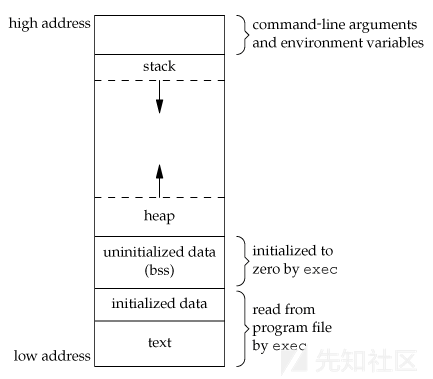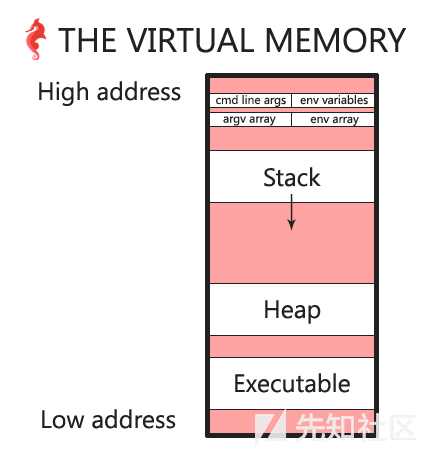Hack 虚拟内存系列(三):虚拟内存图解
本文翻译自:Hack the Virtual Memory: drawing the VM diagram
Hack the Virtual Memory: drawing the VM diagram
Hack虚拟内存之第2章:虚拟内存图解
我们之前讨论过进程的虚拟内存中的内容。今天,我们将通过编写程序打印出各个元素的地址来“重建”(部分)下图。

前提
为了完全理解本文,你需要知道:
- C语言的基础知识
- 汇编的基础知识(非必需)
- Linux文件系统和shell的基础知识
- 我们将用到/proc/[pid]/maps文件(查阅man proc或阅读本系列的第一篇文章: 第0章:C字符串和/proc)
环境
所有脚本和程序都已经在以下系统上进行过测试:
- Ubuntu 14.04 LTS
- Linux ubuntu 4.4.0-31-generic #50~14.04.1-Ubuntu SMP Wed Jul 13 01:07:32 UTC 2016 x86_64 x86_64 x86_64 GNU/Linux
- 下文描述均基于此系统,在其他系统上不一定成功
使用工具:
- gcc
- gcc (Ubuntu 4.8.4-2ubuntu1~14.04.3) 4.8.4
- objdump
- GNU objdump (GNU Binutils for Ubuntu) 2.24
- udcli
- udis86 1.7.2
- bc
- bc 1.06.95
栈
我们想要在图中找到的第一个东西是栈。我们知道在C语言中,局部变量位于栈中。因此,如果我们打印局部变量的地址,那么我们就应该能知道栈在虚拟内存中的位置。让我们使用这个程序(main-1.c)来找出栈的位置:
#include <stdlib.h>
#include <stdio.h>
#include <string.h>
/**
* main - print locations of various elements
*
* Return: EXIT_FAILURE if something failed. Otherwise EXIT_SUCCESS
*/
int main(void)
{
int a;
printf("Address of a: %p\n", (void *)&a);
return (EXIT_SUCCESS);
}julien@holberton:~/holberton/w/hackthevm2$ gcc -Wall -Wextra -pedantic -Werror main-0.c -o 0
julien@holberton:~/holberton/w/hackthevm2$ ./0
Address of a: 0x7ffd14b8bd9c
julien@holberton:~/holberton/w/hackthevm2$当我们比较其他元素地址时,这将是我们的第一个参考点。
堆
当使用malloc为变量分配空间时,将会使用到堆。添加一行代码使用malloc分配空间并查看malloc返回的内存地址位置(main-1.c):
#include <stdlib.h>
#include <stdio.h>
#include <string.h>
/**
* main - print locations of various elements
*
* Return: EXIT_FAILURE if something failed. Otherwise EXIT_SUCCESS
*/
int main(void)
{
int a;
void *p;
printf("Address of a: %p\n", (void *)&a);
p = malloc(98);
if (p == NULL)
{
fprintf(stderr, "Can't malloc\n");
return (EXIT_FAILURE);
}
printf("Allocated space in the heap: %p\n", p);
return (EXIT_SUCCESS);
}julien@holberton:~/holberton/w/hackthevm2$ gcc -Wall -Wextra -pedantic -Werror main-1.c -o 1
julien@holberton:~/holberton/w/hackthevm2$ ./1
Address of a: 0x7ffd4204c554
Allocated space in the heap: 0x901010
julien@holberton:~/holberton/w/hackthevm2$很明显堆地址(0x901010)远小于栈地址(0x7ffd4204c554)。此时我们可以画出草图(堆与栈):

可执行代码区域
程序代码也在虚拟内存中。如果我们打印main函数的地址,我们可以知道程序代码与栈和堆的相对位置。看一下能否在堆下面找到程序代码(main-2.c):
#include <stdlib.h>
#include <stdio.h>
#include <string.h>
/**
* main - print locations of various elements
*
* Return: EXIT_FAILURE if something failed. Otherwise EXIT_SUCCESS
*/
int main(void)
{
int a;
void *p;
printf("Address of a: %p\n", (void *)&a);
p = malloc(98);
if (p == NULL)
{
fprintf(stderr, "Can't malloc\n");
return (EXIT_FAILURE);
}
printf("Allocated space in the heap: %p\n", p);
printf("Address of function main: %p\n", (void *)main);
return (EXIT_SUCCESS);
}julien@holberton:~/holberton/w/hackthevm2$ gcc -Wall -Wextra -Werror main-2.c -o 2
julien@holberton:~/holberton/w/hackthevm2$ ./2
Address of a: 0x7ffdced37d74
Allocated space in the heap: 0x2199010
Address of function main: 0x40060d
julien@holberton:~/holberton/w/hackthevm2$似乎我们的程序地址(0x40060d)正如预期般位于堆地址(0x2199010)下面。
但是,让我们确保这是我们程序的实际代码,而不是某种指向另一个位置的指针。用objdump反汇编我们的程序2并查看main函数的“内存地址”:
julien@holberton:~/holberton/w/hackthevm2$ objdump -M intel -j .text -d 2 | grep '<main>:' -A 5
000000000040060d <main>:
40060d: 55 push rbp
40060e: 48 89 e5 mov rbp,rsp
400611: 48 83 ec 10 sub rsp,0x10
400615: 48 8d 45 f4 lea rax,[rbp-0xc]
400619: 48 89 c6 mov rsi,rax000000000040060d
<main> ->我们找到完全相同的地址(0x40060d)。如果仍不确定,可以打印位于此地址的第一个字节,以确保它们与objdump的输出匹配(main-3.c):#include <stdlib.h>
#include <stdio.h>
#include <string.h>
/**
* main - print locations of various elements
*
* Return: EXIT_FAILURE if something failed. Otherwise EXIT_SUCCESS
*/
int main(void)
{
int a;
void *p;
unsigned int i;
printf("Address of a: %p\n", (void *)&a);
p = malloc(98);
if (p == NULL)
{
fprintf(stderr, "Can't malloc\n");
return (EXIT_FAILURE);
}
printf("Allocated space in the heap: %p\n", p);
printf("Address of function main: %p\n", (void *)main);
printf("First bytes of the main function:\n\t");
for (i = 0; i < 15; i++)
{
printf("%02x ", ((unsigned char *)main)[i]);
}
printf("\n");
return (EXIT_SUCCESS);
}julien@holberton:~/holberton/w/hackthevm2$ gcc -Wall -Wextra -Werror main-3.c -o 3
julien@holberton:~/holberton/w/hackthevm2$ objdump -M intel -j .text -d 3 | grep '<main>:' -A 5
000000000040064d <main>:
40064d: 55 push rbp
40064e: 48 89 e5 mov rbp,rsp
400651: 48 83 ec 10 sub rsp,0x10
400655: 48 8d 45 f0 lea rax,[rbp-0x10]
400659: 48 89 c6 mov rsi,rax
julien@holberton:~/holberton/w/hackthevm2$ ./3
Address of a: 0x7ffeff0f13b0
Allocated space in the heap: 0x8b3010
Address of function main: 0x40064d
First bytes of the main function:
55 48 89 e5 48 83 ec 10 48 8d 45 f0 48 89 c6
julien@holberton:~/holberton/w/hackthevm2$ echo "55 48 89 e5 48 83 ec 10 48 8d 45 f0 48 89 c6" | udcli -64 -x -o 40064d
000000000040064d 55 push rbp
000000000040064e 4889e5 mov rbp, rsp
0000000000400651 4883ec10 sub rsp, 0x10
0000000000400655 488d45f0 lea rax, [rbp-0x10]
0000000000400659 4889c6 mov rsi, rax
julien@holberton:~/holberton/w/hackthevm2$->可以看到程序打印出(和objdump)相同的地址和相同的内容。现在可以十分确定这是main函数地址。
可以在此处下载Udis86反汇编程序库
以下是基于我们刚刚所了解的知识更新后的图表:

命令行参数和环境变量
main函数可以带参数:
- 命令行参数
- main函数的第一个参数(通常命名为argc或ac)是命令行参数的数量
- main函数的第二个参数(通常命名为argv或av)是一个指针数组指向输入的参数(C字符串)
- 环境变量
- main函数的第三个参数(通常命名为env或envp)是一个指针数组指向环境变量(C字符串)
让我们看看这些元素在进程的虚拟内存中的位置(main-4.c):
#include <stdlib.h>
#include <stdio.h>
#include <string.h>
/**
* main - print locations of various elements
*
* Return: EXIT_FAILURE if something failed. Otherwise EXIT_SUCCESS
*/
int main(int ac, char **av, char **env)
{
int a;
void *p;
int i;
printf("Address of a: %p\n", (void *)&a);
p = malloc(98);
if (p == NULL)
{
fprintf(stderr, "Can't malloc\n");
return (EXIT_FAILURE);
}
printf("Allocated space in the heap: %p\n", p);
printf("Address of function main: %p\n", (void *)main);
printf("First bytes of the main function:\n\t");
for (i = 0; i < 15; i++)
{
printf("%02x ", ((unsigned char *)main)[i]);
}
printf("\n");
printf("Address of the array of arguments: %p\n", (void *)av);
printf("Addresses of the arguments:\n\t");
for (i = 0; i < ac; i++)
{
printf("[%s]:%p ", av[i], av[i]);
}
printf("\n");
printf("Address of the array of environment variables: %p\n", (void *)env);
printf("Address of the first environment variable: %p\n", (void *)(env[0]));
return (EXIT_SUCCESS);
}julien@holberton:~/holberton/w/hackthevm2$ gcc -Wall -Wextra -Werror main-4.c -o 4
julien@holberton:~/holberton/w/hackthevm2$ ./4 Hello Holberton School!
Address of a: 0x7ffe7d6d8da0
Allocated space in the heap: 0xc8c010
Address of function main: 0x40069d
First bytes of the main function:
55 48 89 e5 48 83 ec 30 89 7d ec 48 89 75 e0
Address of the array of arguments: 0x7ffe7d6d8e98
Addresses of the arguments:
[./4]:0x7ffe7d6da373 [Hello]:0x7ffe7d6da377 [Holberton]:0x7ffe7d6da37d [School!]:0x7ffe7d6da387
Address of the array of environment variables: 0x7ffe7d6d8ec0
Address of the first environment variables:
[0x7ffe7d6da38f]:"XDG_VTNR=7"
[0x7ffe7d6da39a]:"XDG_SESSION_ID=c2"
[0x7ffe7d6da3ac]:"CLUTTER_IM_MODULE=xim"
julien@holberton:~/holberton/w/hackthevm2$命令行参数和环境变量地址在栈之上,现在我们知道了确切的顺序:stack(0x7ffe7d6d8da0)<argv(0x7ffe7d6d8e98)<env(0x7ffe7d6d8ec0)<arguments(从0x7ffe7d6da373到0x7ffe7d6da387+8(8=字符串“school\0”的长度))<环境变量(从0x7ffe7d6da38f开始)。
实际上,可以看到所有命令行参数在内存中彼此相邻,也紧挨着环境变量。
argv和env数组是否彼此相邻?
argv数组有5个元素(命令行有4个元素,末尾有1个NULL元素(argv总是以NULL标记数组的结尾))。每个元素都是一个指向char型的指针,因为我们在64位机器上,所以指针是8个字节大小(如果你想确定,你可以使用C运算符sizeof()来获得指针的大小)。所以我们的argv数组的大小为5 * 8 = 40。10进制中的40转换成16进制是0x28。如果我们将这个值加到数组的起始地址(0x7ffe7d6d8e98),将会得到0x7ffe7d6d8ec0(env数组的起始地址)!所以两个数组在内存中彼此相邻。
第一个命令行参数是否紧挨着存储在env数组之后?
为了确定这一点,我们需要知道env数组的大小。我们知道它以NULL指针结束,因此为了获得其元素的数量,我们只需要遍历它,检查“current”元素是否为NULL。这是更新后的C代码(main-5.c):
#include <stdlib.h>
#include <stdio.h>
#include <string.h>
/**
* main - print locations of various elements
*
* Return: EXIT_FAILURE if something failed. Otherwise EXIT_SUCCESS
*/
int main(int ac, char **av, char **env)
{
int a;
void *p;
int i;
int size;
printf("Address of a: %p\n", (void *)&a);
p = malloc(98);
if (p == NULL)
{
fprintf(stderr, "Can't malloc\n");
return (EXIT_FAILURE);
}
printf("Allocated space in the heap: %p\n", p);
printf("Address of function main: %p\n", (void *)main);
printf("First bytes of the main function:\n\t");
for (i = 0; i < 15; i++)
{
printf("%02x ", ((unsigned char *)main)[i]);
}
printf("\n");
printf("Address of the array of arguments: %p\n", (void *)av);
printf("Addresses of the arguments:\n\t");
for (i = 0; i < ac; i++)
{
printf("[%s]:%p ", av[i], av[i]);
}
printf("\n");
printf("Address of the array of environment variables: %p\n", (void *)env);
printf("Address of the first environment variables:\n");
for (i = 0; i < 3; i++)
{
printf("\t[%p]:\"%s\"\n", env[i], env[i]);
}
/* size of the env array */
i = 0;
while (env[i] != NULL)
{
i++;
}
i++; /* the NULL pointer */
size = i * sizeof(char *);
printf("Size of the array env: %d elements -> %d bytes (0x%x)\n", i, size, size);
return (EXIT_SUCCESS);
}julien@holberton:~/holberton/w/hackthevm2$ ./5 Hello Betty Holberton!
Address of a: 0x7ffc77598acc
Allocated space in the heap: 0x2216010
Address of function main: 0x40069d
First bytes of the main function:
55 48 89 e5 48 83 ec 40 89 7d dc 48 89 75 d0
Address of the array of arguments: 0x7ffc77598bc8
Addresses of the arguments:
[./5]:0x7ffc7759a374 [Hello]:0x7ffc7759a378 [Betty]:0x7ffc7759a37e [Holberton!]:0x7ffc7759a384
Address of the array of environment variables: 0x7ffc77598bf0
Address of the first environment variables:
[0x7ffc7759a38f]:"XDG_VTNR=7"
[0x7ffc7759a39a]:"XDG_SESSION_ID=c2"
[0x7ffc7759a3ac]:"CLUTTER_IM_MODULE=xim"
Size of the array env: 62 elements -> 496 bytes (0x1f0)
julien@holberton:~/holberton/w/hackthevm2$ bc
bc 1.06.95
Copyright 1991-1994, 1997, 1998, 2000, 2004, 2006 Free Software Foundation, Inc.
This is free software with ABSOLUTELY NO WARRANTY.
For details type `warranty'.
obase=16
ibase=16
1F0+7FFC77598BF0
7FFC77598DE0
quit
julien@holberton:~/holberton/w/hackthevm2$->0x7FFC77598DE0!=(但仍小于)0x7ffc7759a374。所以答案是否定的
更新图表:

栈真的向下生长吗?
让我们调用一个函数并证实这点!如果是真的,则调用函数的变量的内存地址将大于被调用函数的变量的内存地址(main-6.c)。
#include <stdlib.h>
#include <stdio.h>
#include <string.h>
/**
* f - print locations of various elements
*
* Returns: nothing
*/
void f(void)
{
int a;
int b;
int c;
a = 98;
b = 1024;
c = a * b;
printf("[f] a = %d, b = %d, c = a * b = %d\n", a, b, c);
printf("[f] Adresses of a: %p, b = %p, c = %p\n", (void *)&a, (void *)&b, (void *)&c);
}
/**
* main - print locations of various elements
*
* Return: EXIT_FAILURE if something failed. Otherwise EXIT_SUCCESS
*/
int main(int ac, char **av, char **env)
{
int a;
void *p;
int i;
int size;
printf("Address of a: %p\n", (void *)&a);
p = malloc(98);
if (p == NULL)
{
fprintf(stderr, "Can't malloc\n");
return (EXIT_FAILURE);
}
printf("Allocated space in the heap: %p\n", p);
printf("Address of function main: %p\n", (void *)main);
printf("First bytes of the main function:\n\t");
for (i = 0; i < 15; i++)
{
printf("%02x ", ((unsigned char *)main)[i]);
}
printf("\n");
printf("Address of the array of arguments: %p\n", (void *)av);
printf("Addresses of the arguments:\n\t");
for (i = 0; i < ac; i++)
{
printf("[%s]:%p ", av[i], av[i]);
}
printf("\n");
printf("Address of the array of environment variables: %p\n", (void *)env);
printf("Address of the first environment variables:\n");
for (i = 0; i < 3; i++)
{
printf("\t[%p]:\"%s\"\n", env[i], env[i]);
}
/* size of the env array */
i = 0;
while (env[i] != NULL)
{
i++;
}
i++; /* the NULL pointer */
size = i * sizeof(char *);
printf("Size of the array env: %d elements -> %d bytes (0x%x)\n", i, size, size);
f();
return (EXIT_SUCCESS);
}julien@holberton:~/holberton/w/hackthevm2$ gcc -Wall -Wextra -Werror main-6.c -o 6
julien@holberton:~/holberton/w/hackthevm2$ ./6
Address of a: 0x7ffdae53ea4c
Allocated space in the heap: 0xf32010
Address of function main: 0x4006f9
First bytes of the main function:
55 48 89 e5 48 83 ec 40 89 7d dc 48 89 75 d0
Address of the array of arguments: 0x7ffdae53eb48
Addresses of the arguments:
[./6]:0x7ffdae54038b
Address of the array of environment variables: 0x7ffdae53eb58
Address of the first environment variables:
[0x7ffdae54038f]:"XDG_VTNR=7"
[0x7ffdae54039a]:"XDG_SESSION_ID=c2"
[0x7ffdae5403ac]:"CLUTTER_IM_MODULE=xim"
Size of the array env: 62 elements -> 496 bytes (0x1f0)
[f] a = 98, b = 1024, c = a * b = 100352
[f] Adresses of a: 0x7ffdae53ea04, b = 0x7ffdae53ea08, c = 0x7ffdae53ea0c
julien@holberton:~/holberton/w/hackthevm2$->是真的!(函数f中var a的地址)0x7ffdae53ea04 <0x7ffdae53ea4c(函数main中var a的地址)
现在更新我们的图表:

/proc
让我们用/proc/[pid]/maps(man proc或参考本系列的第一篇文章,了解proc文件系统,如果你不知道它是什么)来仔细检查我们到目前为止找到的所有内容。
让我们在程序中添加一个getchar()语句,以便我们可以查看它的“/proc”(main-7.c):
#include <stdlib.h>
#include <stdio.h>
#include <string.h>
/**
* f - print locations of various elements
*
* Returns: nothing
*/
void f(void)
{
int a;
int b;
int c;
a = 98;
b = 1024;
c = a * b;
printf("[f] a = %d, b = %d, c = a * b = %d\n", a, b, c);
printf("[f] Adresses of a: %p, b = %p, c = %p\n", (void *)&a, (void *)&b, (void *)&c);
}
/**
* main - print locations of various elements
*
* Return: EXIT_FAILURE if something failed. Otherwise EXIT_SUCCESS
*/
int main(int ac, char **av, char **env)
{
int a;
void *p;
int i;
int size;
printf("Address of a: %p\n", (void *)&a);
p = malloc(98);
if (p == NULL)
{
fprintf(stderr, "Can't malloc\n");
return (EXIT_FAILURE);
}
printf("Allocated space in the heap: %p\n", p);
printf("Address of function main: %p\n", (void *)main);
printf("First bytes of the main function:\n\t");
for (i = 0; i < 15; i++)
{
printf("%02x ", ((unsigned char *)main)[i]);
}
printf("\n");
printf("Address of the array of arguments: %p\n", (void *)av);
printf("Addresses of the arguments:\n\t");
for (i = 0; i < ac; i++)
{
printf("[%s]:%p ", av[i], av[i]);
}
printf("\n");
printf("Address of the array of environment variables: %p\n", (void *)env);
printf("Address of the first environment variables:\n");
for (i = 0; i < 3; i++)
{
printf("\t[%p]:\"%s\"\n", env[i], env[i]);
}
/* size of the env array */
i = 0;
while (env[i] != NULL)
{
i++;
}
i++; /* the NULL pointer */
size = i * sizeof(char *);
printf("Size of the array env: %d elements -> %d bytes (0x%x)\n", i, size, size);
f();
getchar();
return (EXIT_SUCCESS);
}julien@holberton:~/holberton/w/hackthevm2$ gcc -Wall -Wextra -Werror main-7.c -o 7
julien@holberton:~/holberton/w/hackthevm2$ ./7 Rona is a Legend SRE
Address of a: 0x7fff16c8146c
Allocated space in the heap: 0x2050010
Address of function main: 0x400739
First bytes of the main function:
55 48 89 e5 48 83 ec 40 89 7d dc 48 89 75 d0
Address of the array of arguments: 0x7fff16c81568
Addresses of the arguments:
[./7]:0x7fff16c82376 [Rona]:0x7fff16c8237a [is]:0x7fff16c8237f [a]:0x7fff16c82382 [Legend]:0x7fff16c82384 [SRE]:0x7fff16c8238b
Address of the array of environment variables: 0x7fff16c815a0
Address of the first environment variables:
[0x7fff16c8238f]:"XDG_VTNR=7"
[0x7fff16c8239a]:"XDG_SESSION_ID=c2"
[0x7fff16c823ac]:"CLUTTER_IM_MODULE=xim"
Size of the array env: 62 elements -> 496 bytes (0x1f0)
[f] a = 98, b = 1024, c = a * b = 100352
[f] Adresses of a: 0x7fff16c81424, b = 0x7fff16c81428, c = 0x7fff16c8142cjulien@holberton:~$ ps aux | grep "./7" | grep -v grep
julien 5788 0.0 0.0 4336 628 pts/8 S+ 18:04 0:00 ./7 Rona is a Legend SRE
julien@holberton:~$ cat /proc/5788/maps
00400000-00401000 r-xp 00000000 08:01 171828 /home/julien/holberton/w/hackthevm2/7
00600000-00601000 r--p 00000000 08:01 171828 /home/julien/holberton/w/hackthevm2/7
00601000-00602000 rw-p 00001000 08:01 171828 /home/julien/holberton/w/hackthevm2/7
02050000-02071000 rw-p 00000000 00:00 0 [heap]
7f68caa1c000-7f68cabd6000 r-xp 00000000 08:01 136253 /lib/x86_64-linux-gnu/libc-2.19.so
7f68cabd6000-7f68cadd6000 ---p 001ba000 08:01 136253 /lib/x86_64-linux-gnu/libc-2.19.so
7f68cadd6000-7f68cadda000 r--p 001ba000 08:01 136253 /lib/x86_64-linux-gnu/libc-2.19.so
7f68cadda000-7f68caddc000 rw-p 001be000 08:01 136253 /lib/x86_64-linux-gnu/libc-2.19.so
7f68caddc000-7f68cade1000 rw-p 00000000 00:00 0
7f68cade1000-7f68cae04000 r-xp 00000000 08:01 136229 /lib/x86_64-linux-gnu/ld-2.19.so
7f68cafe8000-7f68cafeb000 rw-p 00000000 00:00 0
7f68cafff000-7f68cb003000 rw-p 00000000 00:00 0
7f68cb003000-7f68cb004000 r--p 00022000 08:01 136229 /lib/x86_64-linux-gnu/ld-2.19.so
7f68cb004000-7f68cb005000 rw-p 00023000 08:01 136229 /lib/x86_64-linux-gnu/ld-2.19.so
7f68cb005000-7f68cb006000 rw-p 00000000 00:00 0
7fff16c62000-7fff16c83000 rw-p 00000000 00:00 0 [stack]
7fff16d07000-7fff16d09000 r--p 00000000 00:00 0 [vvar]
7fff16d09000-7fff16d0b000 r-xp 00000000 00:00 0 [vdso]
ffffffffff600000-ffffffffff601000 r-xp 00000000 00:00 0 [vsyscall]
julien@holberton:~$让我们来确定几件事:
- 栈起始于0x7fff16c62000,结束于0x7fff16c83000。我们的变量都在这个区域内(0x7fff16c8146c,0x7fff16c81424,0x7fff16c81428,0x7fff16c8142c)
- 堆起始于0x02050000,结束于0x02071000。我们分配的内存在此位置(0x2050010)
- 我们的代码(主函数)位于地址0x400739处,在以下区域内:
00400000-00401000 r-xp 00000000 08:01 171828 /home/julien/holberton/w/hackthevm2/7
它来自于文件/home/julien/holberton/w/hackthevm2/7(我们的可执行文件),并且该区域具有执行权限,这是合理的。 - 参数和环境变量(从0x7fff16c81568到0x7fff16c8238f + 0x1f0)位于从0x7fff16c62000开始到0x7fff16c83000的区域,,,栈!所以他们在栈中,而不是在栈之外。
这也带来了更多问题:
- 为什么我们的可执行文件“划分”为三个具有不同权限的区域?在下面这两个区域内有什么?
- 00600000-00601000 r--p 00000000 08:01 171828 /home/julien/holberton/w/hackthevm2/7
- 00601000-00602000 rw-p 00001000 08:01 171828 /home/julien/holberton/w/hackthevm2/7
- 其他那些区域是什么?
- 为什么我们分配的内存不在堆的最开始处(0x2050010 vs 02050000)?前16个字节被用来干什么?
还有一件事我们没有检查过:堆真的在向上增长吗?
以后我们会知道的!在我们结束本章之前,让我们用我们学到的所有东西来更新我们的图表:
